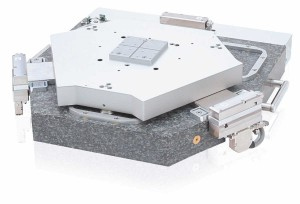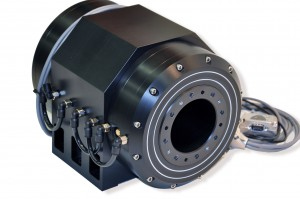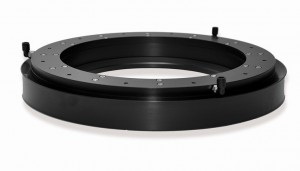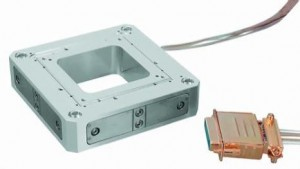 |
| August 16, 2016 | Volume 12 Issue 31 |
Designfax weekly eMagazine
Archives
Partners
Manufacturing Center
Product Spotlight
Modern Applications News
Metalworking Ideas For
Today's Job Shops
Tooling and Production
Strategies for large
metalworking plants
Engineer's Toolbox:
When to use air-bearing stages over mechanical bearings -- and when not to

By Matt Reck, Product Line Manager, Air-Bearing Systems, PI (Physik Instrumente)
WHEN WOULD YOU USE AN AIR BEARING FOR YOUR MOTION CONTROL APPLICATION?
Most motion applications are perfectly well-served by mechanical-bearing guidance, but there are many cases where precision, angular repeatability, and geometric performance must be optimal or where vibration and sub-micron bearing rumble is problematic.
An air-bearing stage can help in these situations.
An air-bearing stage is a rotary or linear positioner that floats on a cushion of air, using one of several preloaded mechanisms, nearly eliminating mechanical contact and thus wear, friction, vibration, and hysteresis effects.
In this article, we present the most common indicators that an air-bearing stage might be the right choice for your application -- and when one might not.
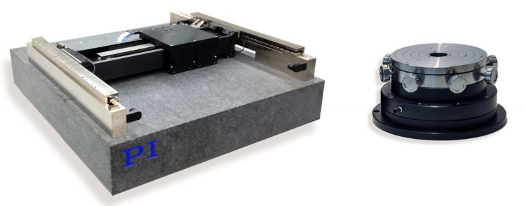
Rotary air-bearing stages reduce wobble and eccentricity significantly over their mechanical counterparts. Three-motor planar XY air-bearing stage with active yaw control (left) and a rotary air-bearing stage (right). [Image: PI]
1. Frictionless, vibrationless, high-precision positioning
A direct-drive motor and high-resolution encoder can position a moving carriage supported by an air bearing to within nanometers in a linear application or within tenths of arc-seconds in rotational applications. The lack of friction and mechanical contact means there is minimal vibration, hysteresis, or reversal error, making it highly repeatable and ideal for many inspection and manufacturing operations. Stiction is virtually eliminated, improving resolution capabilities and reducing in-position "hunting" (limit cycling), and position repeatability can be obtained within a few fundamental encoder counts. Similar precision can be obtained by piezo flexure-guided stages, but over much smaller travel ranges. Magnetic levitation is another option.
VIDEO: How planar air-bearing stages work.
2. Velocity stability and scanning
The lack of mechanical-bearing elements means there is nothing to get in the way of smooth, controlled velocity (stability to better than 0.01 percent). Experiments and processes like inertial sensor testing, tomography, wafer scanning, and surface profiling require continuous motion at tightly controlled speeds and are best served by air-bearing systems.
3. Very low error motions
Linear air-bearing stages have incredibly straight and flat travels, and pitch, roll, and yaw errors can be measured in tenths of arc-seconds. Rotary stages can have tilt (wobble) errors less than 1 arc-second. Additionally, the angular performance of an air bearing is remarkably repeatable. This guarantees optimal part quality and measurement reliability for applications like mirror and optics inspection, semiconductor inspection, and medical device manufacturing. [For more information on geometric performance, read the PI article, "Straightness and Flatness of Air Bearings."]
4. Travel requirements are greater than a flexure stage can provide
Piezo-driven flexure stages and actuators can satisfy many high-precision positioning applications. However, these designs are usually limited to a few millimeters of travel. Use an air-bearing linear stage for travels of 25 mm or more. PI manufactures linear air bearings with travels up to a meter, and even greater with a custom design.
5. When wobble-free or high-speed rotary motion is needed
Rotary air bearings are exceptionally stiff and can deliver highly precise rotary motion. Radial and axial vibration, and wobble error motions, are much smaller than most mechanical bearing solutions can provide, and the rotary motion is very smooth, since there are no roller elements.
Rotary positioning stages generally can achieve speeds up to 600 RPM, while air-bearing spindles are used in higher speed applications. Rotary bearing designs can be mounted with the plane of the table in either the horizontal (i.e., turntable) or vertical orientations.
6. Minimal maintenanceThere are no contacting parts to undergo wear and tear, and no regular maintenance procedures to be performed, like lubrication. An air-bearing stage is essentially maintenance-free. Further, the system is highly stable; since there is no wear, the performance characteristics should not change over the life of the system. There is little need for recalibration. Moving cables and hoses are often the only wear items in an air-bearing system.
7. Cleanliness
Because air bearings are wear-free, they generate virtually no particulates that can become airborne. This makes them ideal for cleanroom applications like optics inspection, wafer inspection, bio-pharma research, and flat-panel display inspection. For extremely clean applications, it is recommended that the air bearing operate using 99.9 percent pure nitrogen.
8. Precise force control and sensing
Air bearings are virtually frictionless, which means when they are coupled with a direct-drive motor or voice coil, they are ideal for micro- and nano-Newton force control applications. Such applications can include pick and place of delicate items, materials testing, and coordinate measuring applications.
--------------------------------------------------------------
WHEN WOULD YOU AVOID AN AIR BEARING FOR YOUR MOTION CONTROL APPLICATION?
1. Vacuum environments
While it is not impossible to operate an air bearing in a vacuum, it is challenging. Vacuum applications should generally be avoided and instead use mechanical bearing, mag-lev, or flexure systems.
2. Very dirty applications
Air bearings are generally used in clean environments. Applications where heavy amounts of dust, dirt, debris, and fluids are present should generally be avoided.
3. Pressurized air or nitrogen is not available
Air bearings require a continuous supply of clean compressed air or nitrogen. If the application does not allow for such a supply to be present, an air bearing cannot be used.
> WATCH air-bearing stages videos.
> READ article, "Straightness and Flatness of Air Bearings."
> LEARN more on PI-USA website.
Published August 2016
Rate this article
View our terms of use and privacy policy

